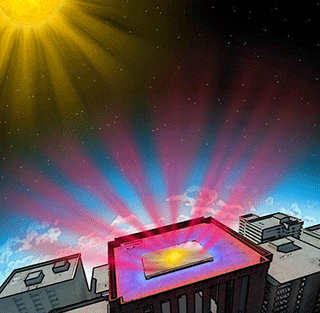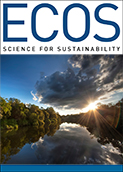
|
Published: 8 December 2014
Smart mirror beams heat from buildings into ‘cold space’
Energy-responsive surfaces like CSIRO’s thin film solar cells are set to make future built environments more sustainable. Now, at Stanford University in the US, researchers have developed an ultrathin material that can cool a building by radiating warmth from inside the building into space, at the same time reflecting sunlight to reduce incoming heat.

|
|
US research engineers have invented a material that reflects incoming sunlight, and sends heat from inside the structure directly into space as infrared radiation. Credit: S Fan/Stanford University
|
A team led by electrical engineering Professor Shanhui Fan and research associate Aaswath Raman recently reported this energy-saving breakthrough in the journal Nature.
The heart of the invention is an ultrathin, multilayered material that deals with light, both invisible and visible, in a new way.
Invisible light in the form of infrared radiation is one of the ways that all objects and living things throw off heat. When we stand in front of a closed oven without touching it, the heat we feel is infrared light. In addition to offloading invisible infrared light, the new material reflects virtually all incoming sunlight back into space.
The result, known as ‘photonic radiative cooling’, produces cooler buildings that require less air-conditioning.
The material is designed to be cost-effective for large-scale deployment on building rooftops, and could one day reduce demand for electricity. (As much as 15 per cent of the energy used in buildings in the US is spent powering air conditioning systems.) It could also be sprayed onto more solid material as a coating.
A warming world needs cooling technologies that don't require power, according to Raman, lead author of the Nature paper. ‘Across the developing world, photonic radiative cooling makes off-grid cooling a possibility in rural regions, in addition to meeting the rising demand for air conditioning in urban areas.’
The ultrathin multilayered coating – just 1.8 microns thick, thinner than the thinnest aluminium foil – has been carefully constructed to send infrared light away from buildings at the precise frequency that allows it to pass through the atmosphere without warming the air. ‘Think about it like having a window into space,’ said Prof Fan.
This multilayered coating also acts as a highly efficient mirror, preventing 97 per cent of sunlight from striking the building and heating it up.
The material comprises seven layers of silicon dioxide and hafnium oxide on top of a thin layer of silver. These layers are not a uniform thickness, but are instead engineered to create a new material.
The Stanford team sees this project as a first step toward using the cold of space as a resource. In the same way that sunlight provides a renewable source of solar energy, the cold universe supplies a nearly unlimited expanse to dump heat.
‘Every object that produces heat has to dump that heat into a heat sink,’ Prof Fan said. ‘What we've done is to create a way that should allow us to use the coldness of the universe as a heat sink during the day.’
Source: Stanford University/Chris Cesare



